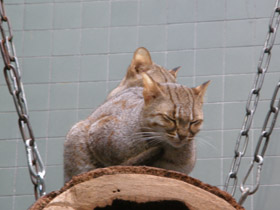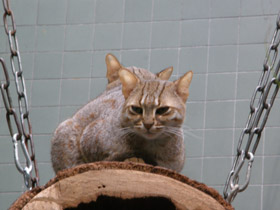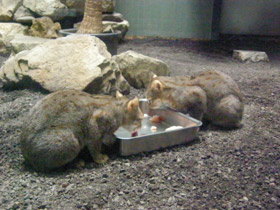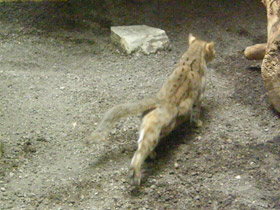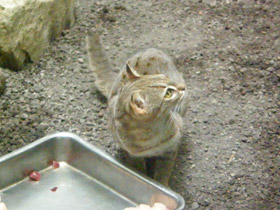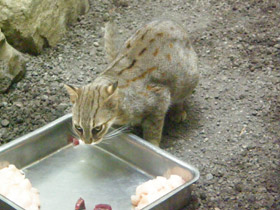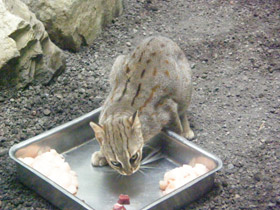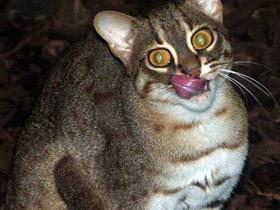The rusty-spotted cat (Prionailurus rubiginosus)
The rusty-spotted cat (Prionailurus rubiginosus) is one of the cat family's smallest members, of which historical records are known only from India and Sri Lanka. In 2012, it was also recorded in the western Terai of Nepal. Since 2016, the global wild population is listed as Near Threatened on the IUCN Red List as it is fragmented and affected by loss and destruction of its prime habitat, deciduous forests.
Taxonomy
Felis rubiginosa was the scientific name used by Isidore Geoffroy Saint-Hilaire in 1831 for a rusty-spotted cat specimen from Pondicherry, India. Prionailurus was proposed by Nikolai Severtzov in 1858 as a generic name. Prionailurus rubiginosus phillipsi was proposed by Reginald Innes Pocock in 1939 who described a specimen from Central Province, Sri Lanka and subordinated both to the genus Prionailurus.
Appearance
Prionailurus rubiginosus is the smallest extant species of wild cat, ranging in body length from 35-48 cm and weighing only 0.9-1.6 kg. The appearance of the rusty, or spotted red, cat is very similar to that of Prionailurus bengalensis, and all its names do not correctly reflect the true colour of the animal. In fact, the red spotted cat has a short, smooth grey, sometimes brownish coat, covered only with diffuse reddish patches on the legs, back and sides. The cat's coat is lighter in colour with large dark patches on the belly. The rusty cat has a slender body, short legs and a relatively short tail (15 to 30 cm); the head is rounded, with small ears. Its grey or honey-coloured eyes are disproportionately large, giving them an unusual expression.
Habitat and nutrition
Found in Sri Lanka and India. Subspecies Prionailurus rubiginosus rubiginosus is restricted to southern India, while Prionailurus rubiginosus koladivinus and Prionailurus rubiginosus phillipsi are found in Sri Lanka.
Prionailurus rubiginosus inhabits a wide variety of habitats, ranging from low-growing wet and dry deciduous forests and dense thickets to waterless terrain and open fields. The presence of a nearby body of water is an important advantage when choosing a habitat.
This diminutive raptor leads a nocturnal arboreal lifestyle and hunts both on the ground and in trees, especially at night. Prionailurus rubiginosus feeds on mice and other rodents, birds, lizards and insects. The small size of this predator allows it to go unnoticed by its enemies. The cat's safety is also ensured by the surrounding trees, which the animal instantly climbs in alarm situations.
There are two distinct populations of Prionailurus rubiginosus, often recognised as separate subspecies. One inhabits southern India and the other the island of Ceylon.
They live in very different habitats: Ceylon cats live in the rainforest, while the Indian population lives in dry, open areas. According to one theory, competition from Prionailurus bengalensis, which does not exist in Ceylon, caused the rusty cat from the Indian subcontinent to adapt to the new area.
Social behaviour and reproduction
Prionailurus rubiginosus leads a solitary lifestyle, each animal occupying a specific area of 15-20 km2, the boundaries of which it marks with its urine. Courtship in Prionailurus rubiginosus is almost the same as in domestic animals. The male recognises females by the sounds they make and by their scent. He approaches the female and rubs his head on her cheeks and neck. However, the females do not immediately accept these advances, first hissing and pawing at the males, sniffing their scent marks and increasing the frequency of their own markings.
The gestation of this cat lasts between 67 and 71 days, after which 1 to 3 kittens (but most often one) are born in the den. The newborn kittens have an even less subdued name than the adults, their colour is almost devoid of red tones. Kittens grow rapidly and reach sexual maturity at the age of 10-12 months.
Prionailurus rubiginosus is extremely rare and is listed on the International Red List and the CITES Convention. It is threatened by deforestation and human encroachment on its habitat. The species is endangered, as there are fewer than 10,000 individuals and their numbers tend to decline steadily due to habitat changes. The species is rarely kept in zoos, but the Berlin zoo has even managed to breed them.
Threats
Habitat loss and the spread of cultivation are serious problems for wildlife in both India and Sri Lanka. Although there are several records of the rusty-spotted cat in cultivated and settled areas, it is not known to what degree these populations are able to persist in such areas. There have been occasional reports of rusty-spotted cat skins in trade. In some areas, it is hunted for food or as livestock pest.
Conservation
The Indian population is listed on CITES Appendix I. The Sri Lankan population is included on CITES Appendix II. The species is fully protected over most of its range, with hunting and trade banned in India and Sri Lanka.
As of 2010, the captive population of Prionailurus rubiginosus phillipsi comprised 56 individuals in eight institutions, of which 11 individuals were kept in the Colombo Zoo in Sri Lanka and 45 individuals in seven European zoos.
Local names
In Sri Lanka, the rusty-spotted cat is known as kola diviya (කොළ දිවියා) or balal diviya (බළල් දිවියා).

















